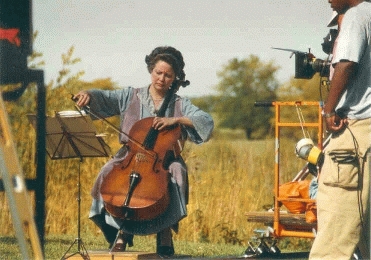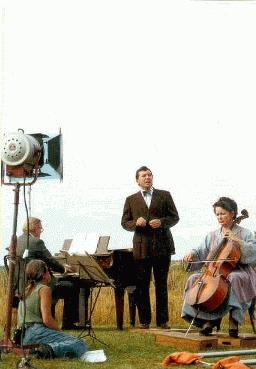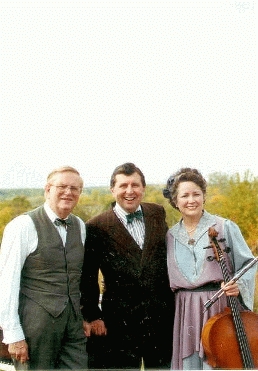
Musicelli's Barbara Hedlund, in her new role as "The Prairie Mother"
New PBS Video & CD Pays Homage to Carl Sandburg, the Prairie, and Midwestern Valuesby Barbara Hedlund |
The world premiere of The Song and the Slogan took place on November 14, 2000, at the Krannert Center for the Performing Arts, Urbana, IL. The concert presented internationally renowned tenor Jerry Hadley, a three-time Grammy Award winner and featured artist in major opera houses throughout the world. A special guest reader was David Hartman, former creator and host of ABC TV's "Good Morning America." Mr. Hartman currently has his own award winning production company concentrating primarily on documentaries. In his ever-familiar stentorian resonance, David Hartman read selected poems of Sandburg at the concert as introductions to related songs. In addition, he narrates and appears in the new documentary/Classical music video.

Musicelli's Barbara Hedlund, in her new role as "The Prairie Mother"
The Song and the Slogan was commissioned in 1996 as a tribute to Jerry Hadley's Midwestern Illinois heritage. He called upon a composer friend to set Carl Sandburg's poetry to music. Daniel Steven Crafts, a Midwesterner originally from Michigan, set the two prominent instrumental parts in the piano ("as the heart") and the cello ("as the soul") with supporting woodwinds, banjo, and percussion. Inspired by Sandburg's celebrated poem "Prairie," the title The Song and the Slogan was derived from the first lines of the poem, "I was born on the prairie and milk of its wheat, the eyes if its women, gave me a song and a slogan. Here I know I'll hanker after nothing so much as one more sun rise or a sky moon of fire doubled to a river of water."
How does one get immersed for three years to date in such a project co-producing, performing, recording, scheduling, arranging housing, and more? It began as the result of a casual post recital conversation with Jerry Hadley who had just performed with Thomas Hampson at the Krannert Center. Longtime colleagues of Jerry's, we performed in Tosca in 1978 at the Lake George Opera. My husband, bass baritone Ronald Hedlund, sang in the same production and in various others with Jerry around the US.

Pianist Eric Dalheim, three-time Grammy Winner and Metropolitan Opera Tenor
Jerry Hadley, Cellist Barbara Hedlund, and Sandy Talbot, film crew (and personal page turner!)
Jerry was scouting locations to premiere the work so I suggested, "Why not in Central Illinois?" Several factors were imminently clear to me: 1) The work was in homage to Jerry Hadley�s Midwestern roots. 2) He is an Illinois native and a Bradley University and UI graduate. Jerry Hadley is one of the most distinguished alumni of the University of Illinois School of Music. 3) The featured poetry focused on references to the Midwest. 4) The Sandburg archives are housed in the Rare Book Collection at the UI. 5) The Sandburg home and museum are located in Galesburg, IL. A decision was made to have the premiere concert and ancillary events benefit the School of Music Opera Program where Jerry performed his first operatic roles.
Who would turn down a chance to work with such a talented, world-renowned artist who charms and captivates everyone who hears him? I certainly wasn�t going to! Jerry was off to other engagements and returned to campus in 1997 for preproduction meetings with the UI School of Music administration and WILL-TV producer. Immediately grasping the all encompassing benefits of the work, they helped set things in motion. Suddenly I was deeply involved, yet still had not seen the cello part.
From a cellistic view point, what I perceived as a typical ensemble part pleasantly surprised me. The score contains a prominent opening solo and closing of the work plus featured solo lines throughout. Daniel Steven Craft's writing for the cello in The Song and Slogan resembles a 19th century melodic style. It lies in a comfortable accessible register prominent throughout in the manner of an obbligato solo line. There are passages of exposed double stops and various solos without the voice. The range covers essentially three octaves starting from the open C string. It ends on a high D false harmonic held unwavering for the final four bars. During the work's evolution, the composer sat patiently while I played through the part for him. Suggestions were offered how to make the part more idiomatically accessible yet not remove a sense of challenge. From the very outset his writing indicated a strong understanding of the capabilities and singing range of the cello, so very few changes were required.

Eric Dalheim, Jerry Hadley, Barbara Hedlund
The recording session in September 2000 at the UI Smith Memorial Hall was fairly typical, although we were unable to use the preferred site at the Krannert Center. That meant coordinating with UI Operations and Maintenance to turn off the air-conditioning fans and have the hall silenced at remote hours to avoid sound leakage. Professors and students cooperated by evacuating the building or by remaining quiet during the two night recording sessions. Later assisting the engineer to edit the CD using new technological advances was an enlightening experience for me.
Filming began in early October 2000 sandwiched between Jerry Hadley's appearances as Jay Gatsby in John Harbison's new opera The Great Gatsby at the Chicago Lyric Opera. (The Great Gatsby was premiered at the Metropolitan Opera last season also starring Jerry Hadley.) We met each day at 7:30am and drove 70 miles to the set to capture the perfect fall Indian summer lighting conditions, returning home at 8pm. A strip of restored prairie grasses at the Mackinaw Dells rest area near Morton, IL served as the backdrop for the film. In period costumes from the 1920s, looking like a Chautauqua Sunday morning meeting, we performed amongst the crew shifting lights, reflectors, and cameras. "Hurry up and wait" became the order of the day. Repeatedly all day long we took our places in the glaring sun. Jerry joked that John Wayne made a career out of squinting, so perhaps our luck will follow? For one week, we endured extremes of glaring sun, heat, cold, and rain in order to complete the shoot. The bonus to waiting around was having lots of time to practice for two chamber music recitals surrounding the shoot. Practicing on a junker cello wasn't ideal, but considering the weather, the risk to my Garavaglia cello was formidable. The piano on the set was not tuned, nor would it have been effective for outdoors. Sounding like a honkey tonk piano, it caused waves of laughter as we synched with our prerecorded sound track.
Synching without a conductor was challenging and occasionally required memorizing musical segments. Hiding the music from the camera meant woodwind music was pinned to the back of my chair or dress or taped to the side of the piano. It also tested the skill and patience of the cameraman and producer. Visitors to the rest stop were treated to an entertaining and surprising respite.
Jerry Hadley feels that "Carl Sandburg's writings reflect Midwestern values, work ethics, stoic pragmatism, and unconquerable spirit. I want the listener and viewer to be so touched by the work and film that they come away feeling as if they've experienced the prairie, been touched by the poetry and music, feel they are heirs to the pride of Midwesterners and their values." The November 14th concert received standing ovations and subsequent invitations to present the program in other venues. Interested parties can make inquiries to vcello1@aol.com.

Jordan Kaye, Banjo, James Scott, flute
Performers for the CD and film include: David Hartman, narrator, Jerry Hadley, tenor, Paul Vermel, conductor, Eric Dalheim, piano, Barbara Hedlund, violoncello, James Scott, flute, Alison Robuck, oboe, Solomon Baer, clarinet, Kazimierz Machala, French horn, Jordan Kaye, banjo, and Ricardo Flores, percussion.
A parting gift from the composer was a new work for cello and piano documenting the project. Titled the Barbara Suite, we renamed it with Dan�s consent to the Prairie Mother Suite. Working on the project had earned me another new nickname! The premiere of the suite will undoubtedly take place in 2001. The four movements of the work are titled:
Barbara Hedlund (The Prairie Mother)
November 30, 2000
For information on Barbara Hedlund's Virtuoso Obbligato Aria Collection and Laszlo Varga's MusiCelli arrangements for solo cello and cello ensemble, go to http://members.aol.com/vcello1/.
For tenor Jerry Hadley's web site go to http://www.hadleyweb.com.
For composer Daniel Steven Crafts' web site go to http://www.dscrafts.net.

| Direct correspondence to the appropriate ICS
Staff Webmaster: Michael Pimomo Director: John Michel Copyright © 1995- Internet Cello Society |
|---|